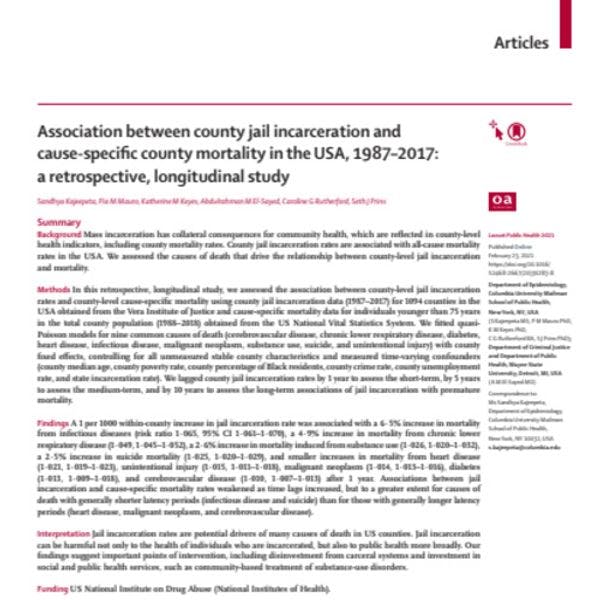The Lancet
Association between county jail incarceration and cause-specific county mortality in the USA, 1987–2017: A retrospective, longitudinal study
By Sandhya Kajeepeta et al. / The Lancet
Mass incarceration is associated with widespread conse quences for community health, some of which extend beyond people who are and have been incarcerated and their immediate networks. Residents of neighbourhoods with high rates of prison incarceration have a higher risk of major depressive disorder, generalised anxiety disorder, dyslipidaemia, and metabolic syndrome than do residents of neighbourhoods with low prison incarceration rates. Nosrati and colleagues found that a standard devia tion increase in the rate of county jail admissions was associated with a 2% increase in countylevel mortality from drug use disorder. We previously found that an increase from the first to the second quartile of within county rates of jail incarceration was associated with a 3% increase in the allcause mortality rate.
Jail incarceration in the USA operates as an institutional product of structural racism that disproportionately affects Black Americans. Black people are nearly four times more likely to be incarcerated in local jails than white people. Moreover, the US criminal legal system disproportion ately criminalises and punishes poor people. The health effects of communitylevel exposure to high rates of jail incarceration might contribute to and worsen existing racialised and classbased health disparities. For example, during the COVID19 pandemic, jails exacerbated the spread of the virus in communities that were already at a disproportionately higher risk of infection.
Increases in rates of county jail incarceration are associated with subsequent increases in county allcause mortality rates. However, allcause mortality is a hetero geneous outcome that includes deaths caused by chronic diseases, injuries, and infectious diseases. Identification of the specific causes of death that drive the observed association can help to elucidate potential mechanisms. Furthermore, if the relationship between the rates of county jail incarceration and county mortality is causal and not merely a shared consequence of concentrated and racialised disadvantage, we would expect jail incarceration rates to influence deaths from different causes to differing degrees and via differing mechanisms.
